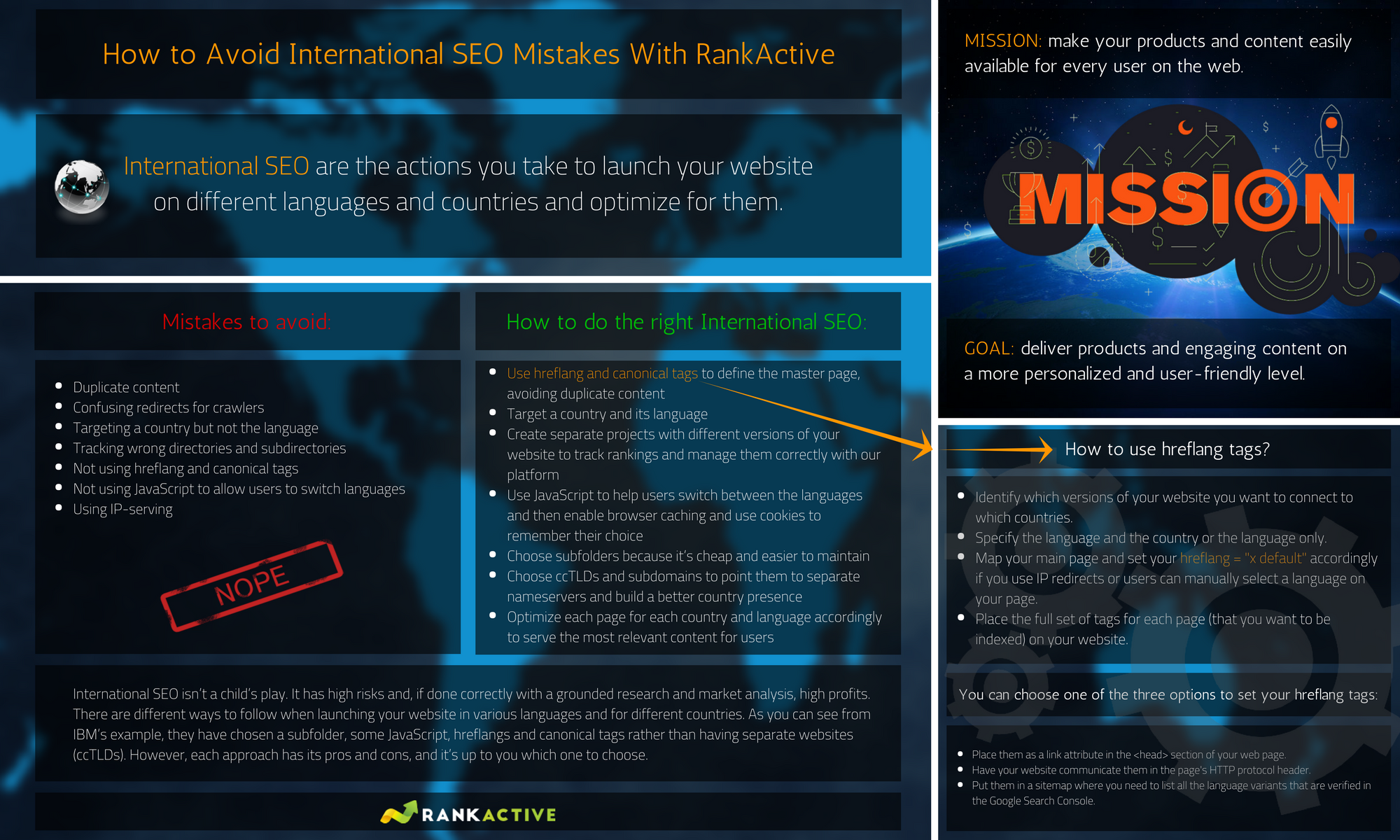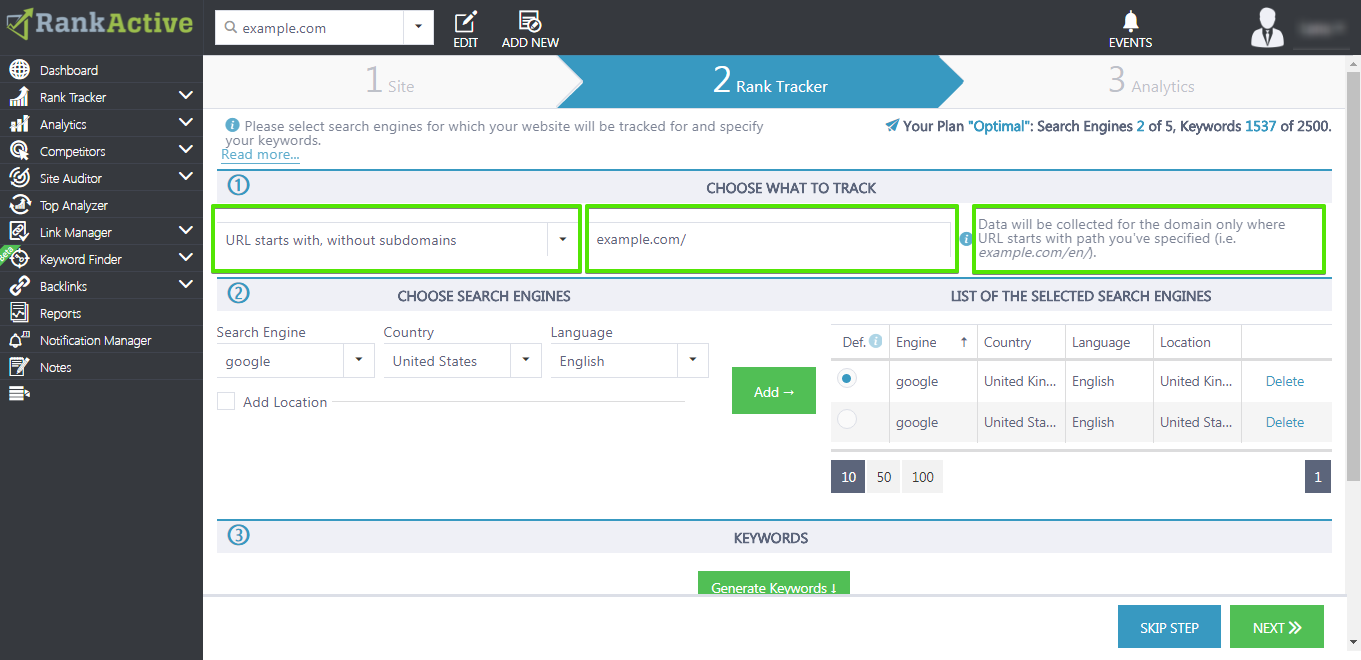How to Avoid International SEO Mistakes With RankActive
8 May 2018 Leave a comment ALL-HANDS SEO
International SEO are the actions you take to launch your website on different languages and countries and optimize for them. International SEO or geotargeting is sometimes like a refresh button, depending on which approach you choose. When companies decide to distribute their products in different countries, they need to lingualize their website to establish better customer relationships and meet their clients’ needs, as well as their own, of course.
Why is it a refresh button? Because quite often when you launch different versions of your website, you will have to do all the SEO from the start for each language. This may be a hell of a struggle which even big companies face. Learn from their fails to avoid the most common international SEO issues.
IBM’s experience with geotargeting
Launching an international website is a challenge worth completing when you decide to distribute products on a more personalized and user-friendly level. When IBM tried to roll out their website on different languages, they faced duplicate content issues, which prevented IBM’s pages from crawling. Google is quite captious in content and indexability matters. It’s reasonable to be well-aware of possible mistakes and solutions to them.
An issue may arise when you try to implement the country and language code (cc-lc) in the URL. For example, you want to target different countries but use the same languages. As, for instance, UK and US both speak English and your website originates from US therefore US content updates faster. In order to deliver the news for UK as quickly as possible, you may think of cc-lc which will, eventually, be ignored by Google if you implement it incorrectly. For example, if you simply copy and paste the content. Google will get lost between the two pages and will be confused which one to rank first, while another page will be identified as duplicate content and rarely crawled or banned.
When you’re optimizing your website for different languages and markets, it’s not different from usual SEO. This is like a whole different website which you need to maintain. And this is why when you optimize for different countries you need to think about your pricing pages. The expenses may be much higher to rank your UK page than US one, especially to outrank your own pages for specific countries. So, your UK marketing and SEO teams may spend more money on boosting the UK version of your website, thus you might think of establishing different pricing policy for the same product to cover the expenses.
Creating a subfolder
The advantage of creating subfolder is that all the content is on the same website and is easier to manage, track and rank.
A good idea would be to allow users to switch between the languages on the page so that when you’ve built a redirect profile, you won’t catch crawler in that loop of redirects. And by enabling browser caching and cookies, you can easily target the right audience in the right country and language. With a subfolder you can specify the country code and the language that matches the country.
The disadvantage of subfolders is that you can’t point them to a separate name server and they may look less geotargeted according to some beliefs about user preferences.
What can you do to manage your subfolders more accurately and effectively? Here is how RankActive can help you out.
When you create a new project, you can specify not only your domain name but also the exact URL (subdirectory). You will get rankings, different information about on-page SEO factors and other stats for this URL and everything that follows after it. For example, https://example.com/en/. Not only this subfolder will be tracked but everything that belongs to this version of your website, such as, for instance, https://example.com/en/blog/…, https://example.com/en/products/…, etc.
So, back to IBM struggle. After realizing their total mistake, IBM recovered and decided to implement cc-lc code to the front of the URL string and registered it Google Search Console. It worked fairly well for them, but for as long as there was no duplicate content. Soon after they found a way to rank their pages and combined this technique with hreflang and canonical tags.
How to use hreflang tags?
- Identify which versions of your website you want to connect to which countries.
- Specify the language and the country or the language only. However, you can’t use country only due to the mentioned above language peculiarities in different countries.
- You need to map your main page and set your hreflang = “x default” accordingly if you use IP redirects or users can manually select a language on your page.
- You must place the full set of tags for each page (that you want to be indexed) on your website.
You can choose one of the three options to set your hreflang tags:
- Place them as a link attribute in thesection of your web page.
- Have your website communicate them in the page’s HTTP protocol header.
- Put them in a sitemap where you need to list all the language variants that are verified in the Google Search Console.
When this was done properly, Google would show the right page in the necessary language for the right country. Would that stop Google from making a mess?
No. As IBM declares, Google started aggressively deleting their pages claiming them duplicate. The removal from SERPs was happening outside the ranking algorithm and could not be prevented. The mystery wasn’t revealed, however, SEOs are concerned that 70% of similar text would be considered as duplicate content and would, eventually, be blocked from indexation.
What Google suggests is that you need to create unique content for each language and country. That is far from being a solution if you’re running your business in numerous languages and many countries. You’ll need a legion of copywriters and marketers which isn’t necessarily what you’re looking for. Money saved is money earned. Instead of translating tonnes of content for each country and each language you may think of consolidating your pages into one canonical page. IBM’s solution is to publish one URL per language for each marketing page, enabling dynamic systems to load the differences between the pages, such as pricing and other user experiences.
Apart from creating a subfolder, there are some other options that you may go with.
ccTLD
ccTLD stands for a country code top-level domain, for example, http://example.de/ where .de is ccTLD. When you decide to target different countries and languages this approach can work for you absolutely well. This is, however, very expensive and time-consuming to buy domains for each country code you want to geotarget.
The main advantages are that you can have separate name servers for each website, you can track all the rankings and traffic and identify all the on-page issues (titles, meta descriptions, 404 pages, non-canonical tags, etc.) with Site Auditor. Also, if you add your projects separately, as we have mentioned earlier, you can see the issues for each version of your website. If you stick to ccTLDs, you can build a better country presence around the website, and it will be reasonable specify your prices accordingly, since your marketing campaign and SEO may require higher expenses.
Some believe that people in Canada, for example, would rather click on .ca then .com, though it’s still English, so take it into consideration when you optimize for international SEO. What’s bad about ccTLDs is that you can target the code country, but you can’t target the code language. For example, if you have .de website, how would a user know if it’s a country or a language?
Subdomain
A way to cut the expenses from ccTLDs would be to avoid them and use your main domain, but to create as many country targeted subdomains as you need, such as https://en.example.com/.
The advantages are that you can customize your hostings by pointing DNS to a web server that is located the closest to the targeted audience. As Google considers subdomain to be an independent unit you can fully support, maintain and track it either with Google Search console or with our platform. How to track your rankings separately from the main domain, i.e., getting information about rankings and traffic for each subdomain (language version of your website)? In our tool Rank Tracker you can specify what to track. In the picture below you can see a lot of options to choose for tracking purposes such as domain, exact URL, etc.
When users come to your website you might detect which country they come from and you can redirect them to a specific homepage with the proper language for this user. For better localization preferences you can choose between country or language targeting and you can use cookies to enable a single sign in for seamless user experience.
You can use javascript and allow users to choose their country and specify their language so then you can redirect them to the necessary page. Once you’ve identified that user you can now allow cookies to remember them so that they will be redirected to the right page. Make sure you don’t use such a way of redirection by default and avoid IP serving because you might target wrong users and direct them to the wrong web
page country settings.
The disadvantages of subdomain are that you can’t localize the domain name itself as with ccTLDs and it looks less local for picky users.
Also, what Google suggests using as a must is hreflangs tags and canonical tags for specifying which page is the master page in order to erase all the duplicate content issues. You can implement them whether you’re using ccTLDs, subdomains or subfolders.
Conclusions
International SEO isn’t a child’s play. It has high risks and, if done correctly with a grounded research and market analysis, high profits. There are different ways to follow when launching your website in various languages and for different countries. As you can see from IBM’s example, they have chosen a subfolder, some JavaScript, hreflangs and canonical tags rather than having separate websites (ccTLDs). However, each approach has its pros and cons, and it’s up to you which one to choose.
Liked the article? Want to keep the main ideas at hand? Click Download Infographics below!:)

Tags: international SEO, multilingual, optimize for languages
Like this article? There’s more where that came from.
- 5 Questions to Ask Yourself Before Paying for Rank Tracking Software
- 5 Serious Mistakes Beginner SEOs Make and How to Fix Them
- Why We Use Google’s New Link Attributes and You Should Too
- Title and Description in 2021: Why Google Rewrites SEOs’ Meta Tags
- What We Should Learn From Google’s “About This Result” Feature



